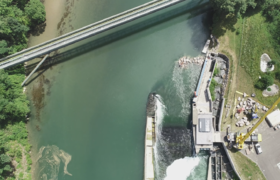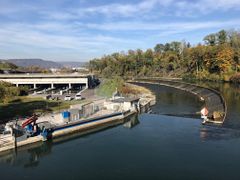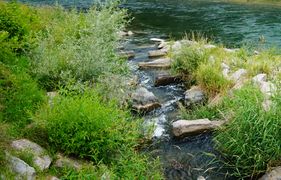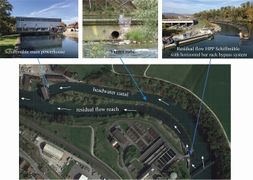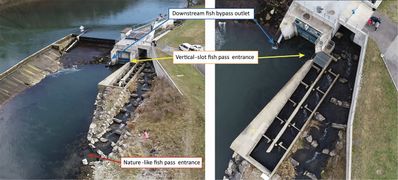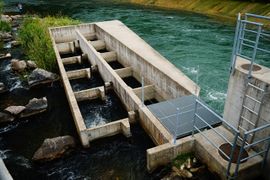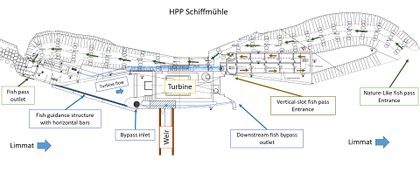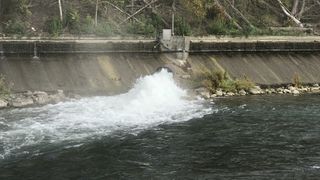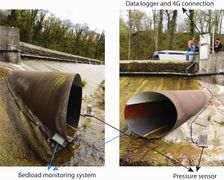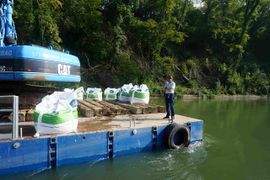Difference between revisions of "Schiffmühle test case"
Robert Boes (talk | contribs) |
Robert Boes (talk | contribs) |
||
| Line 27: | Line 27: | ||
===Upstream migration=== | ===Upstream migration=== | ||
| − | HPP Schiffmühle has a combination of a nature-like and a technical fish pass (vertical slot) for upstream migration. The entrances of the nature-like fish pass and the vertical slot pass are located approx. 36 m and 2 m downstream of the turbine's suction tube outlet, respectively. The technical and the nature-like fish passes merge at an elevation of 336.83 m a.s.l. (see figures in | + | HPP Schiffmühle has a combination of a nature-like and a technical fish pass (vertical slot) for upstream migration. The entrances of the nature-like fish pass and the vertical slot pass are located approx. 36 m and 2 m downstream of the turbine's suction tube outlet, respectively. The technical and the nature-like fish passes merge at an elevation of 336.83 m a.s.l. (see figures in the Gallery). From there on upwards, fish use the nature-like pass. The total discharge in the fishway is 0.5 m<sup>3</sup>/s. |
To monitor upstream migration and fish behavior in the migration facilities, 5 PIT-tag antennas have been installed in the technical vertical slot fish pass and in the nature-like pass. | To monitor upstream migration and fish behavior in the migration facilities, 5 PIT-tag antennas have been installed in the technical vertical slot fish pass and in the nature-like pass. | ||
Revision as of 09:02, 28 April 2020
| Fact box: Schiffmühle | |
|---|---|
| Country | Switzerland |
| River | Limmat |
| Operator | Limmatkraftwerke AG |
| Capacity | 0.5 MW |
| Head | 2.97 m |
| Inter-annual discharge | 14 m3/s |
| Turbine(s) | 1 Bevel gear bulb turbine |
| Detailed report | Click for pdf |
Contents
Introduction
The hydropower plant (HPP) Schiffmühle is a run-of-the-river HPP located on the 35 km long stretch of the Limmat river in the communities of Untersiggenthal and Turgi near Baden, some 27 km downstream of Lake Zurich. Between lake Zurich and Schiffmühle there are seven HPPs, namely in flow direction Letten, Höngg , Dietikon, Wettingen, Aue, Oederlin and Kappelerhof. There are three more HPPs between HPP Schiffmühle and the junction with the Aare river, namely Turgi, Gebenstorf and Stroppel. The lowest and highest points of the Limmat river are 330 m and 406 m asl, respectively. The surface area of the whole catchment amounts to 2384 km2, of which 0.7 % are glaciated.
On river Limmat, the mean monthly discharge increases from March to June and then decreases from July to October. The annual discharge in 2015 was 89 m3/s, while the long-term average is 101 m3/s (1951-2015).
About the hydropower plant
At Schiffmühle, hydropower is exploited in two run-of-river HPPs, namely the main powerhouse located at the end of a headrace channel on the right shore and the residual flow HPP situated next to a flap gate at the upstream end of the weir on the left shore (see Gallery, layout of HPP Schiffmühle). In the scope of FIThydro, the residual flow HPP is the investigated case study HPP. This HPP has an installed capacity of 0.5 MW and a mean annual output of 1.9 GWh. It operates with a bevel gear bulb turbine.
The Operator: Limmatkraftwerke AG (LKW)
LKW produces environmentally friendly and local electricity from four main and two residual flow hydropower plants on river Limmat between Baden and Turgi. The company is owned by the Regionalwerke Holding AG Baden (60%), a local utility company, and the regional power company AEW (40%). The Regionalwerke AG Baden is responsible for the operation of the HPPs and all technical and energy management issues. The administrative and financial management are performed by Axpo AG. The average annual energy output is around 91 GWh. The company fulfills the standards according to ISO 9001 and the production of renewable energy is certified by TÜV SÜD Erzeugung EE.
Pressures on the water body's ecosystem
The river Limmat is located in the Rhine river catchment, which was historically one of the most important Atlantic salmon rivers in Europe. The upstream migration of salmons (Salmo salar) in the Rhine catchment became almost impossible due to transverse structures such as hydropower plants. In the past few years a number of HPPs on the Rhine, Aare and Limmat rivers have been equipped with state-of-the-art fish passage facilities for upstream migration. However, downstream migration measures and sediment management strategies have hardly been realized. Furthermore, the Limmat river is highly influenced by HPPs and densely populated areas and considered as a heavily modified water body. The river has a moderate ecological potential. Various measures for sediment control, fish migration, flow changes, habitat in-channel and morphology off-channel have been implemented in the water body.
Test case topics
Fish population
All of the existing fish species in the Limmat river (at least 22 species) face potential mortality during their downstream migration, some of which also have difficulties to migrate upstream. Some of the most important species are: Eel (Anguilla anguilla), Brown trout, Common barbel (Barbus barbus), Grayling, Spirlin, Nase, Chub, Bleak.
Downstream migration
At the residual flow HPP Schiffmühle, an angled fish guidance structure with horizontal bars, termed Horizontal Bar Rack (HBR), has been implemented in 2013 to shield fish from the turbine intake and guide them into a bypass and to the tailwater. The rack is positioned parallel to the main flow to have a lateral intake. The HBR has a length of 14.6 m and a spacing of 20 mm between the bars, which are positioned in a vertical angle of 90°. At the end of the rack there is the bypass inlet with three openings in a vertical chamber in different water depths (close to the bottom, central and close to the surface). From there, a 25 cm diameter pipe bypasses the fish downstream, letting them out at about 0.20 m above the tailwater level. The discharge in the bypass is 170 l/s.
For monitoring downstream migrating fish, 1 PIT-tag antenna has been installed at the bypass pipe inlet.
Upstream migration
HPP Schiffmühle has a combination of a nature-like and a technical fish pass (vertical slot) for upstream migration. The entrances of the nature-like fish pass and the vertical slot pass are located approx. 36 m and 2 m downstream of the turbine's suction tube outlet, respectively. The technical and the nature-like fish passes merge at an elevation of 336.83 m a.s.l. (see figures in the Gallery). From there on upwards, fish use the nature-like pass. The total discharge in the fishway is 0.5 m3/s.
To monitor upstream migration and fish behavior in the migration facilities, 5 PIT-tag antennas have been installed in the technical vertical slot fish pass and in the nature-like pass.
E-flow
The HPP Schiffmühle supplies up to 14.6 m3/s of turbine water and 0.67 m3/s of the water in the fish ladders (upstream and downstream) to the downstream river reach as e-flow. Moreover, during high river discharges, additional water is supplied over the frontal weir at the HPP and over the side weir along the power canal to the residual flow reach.
Sediment management
An innovative vortex tube for bed load transport connectivity, sediment flushing through weirs and upstream and downstream fish migration facilities have been in operation at the residual flow HPP Schiffmühle.
Research objectives and tasks
The planned studies at HPP Schiffmühle will address various aspects of upstream and downstream fish passes, downstream habitat and sediment transport. The findings of the studies will have a wide range of applications for other similarly sized HPPs and answer the fundamental questions on the fish behavior at fish passes.
Research tasks
The research tasks and field studies conducted at Schiffmühle are:
- Field campaign: hydraulics, habitat, attraction flow and Lateral Line Probe in fish ladder
- 3D numerical model of HPP area
- Fish monitoring
- Bed load monitoring at vortex tube
- Habitat and sediment modelling
Results
The flow condition at the entrance of the nature-like fishway of the residual flow HPP Schiffmühle is more attractive for all monitored fish species than the flow condition at the entrance of the vertical slot fishway. However, the fish entrance efficiency is higher for the vertical slot fishway. Overall, the passage efficiency of the fish pass system is high (> 80 % for most species) indicating that it is designed and functions well.
Regarding downstream fish migration, velocity measurements and fish monitoring results show that the attraction flow to the bypass of fish protection and guidance structure at the HPP (Horizontal Bar Rack-Bypass System) is inefficient and needs an optimization. Such result indicates that design, location and operation of a bypass system is of prime importance for a successful implementation and high efficiency of a fish guidance structure. Using a 3D numerical model, alternative bypass designs are currently investigated.
